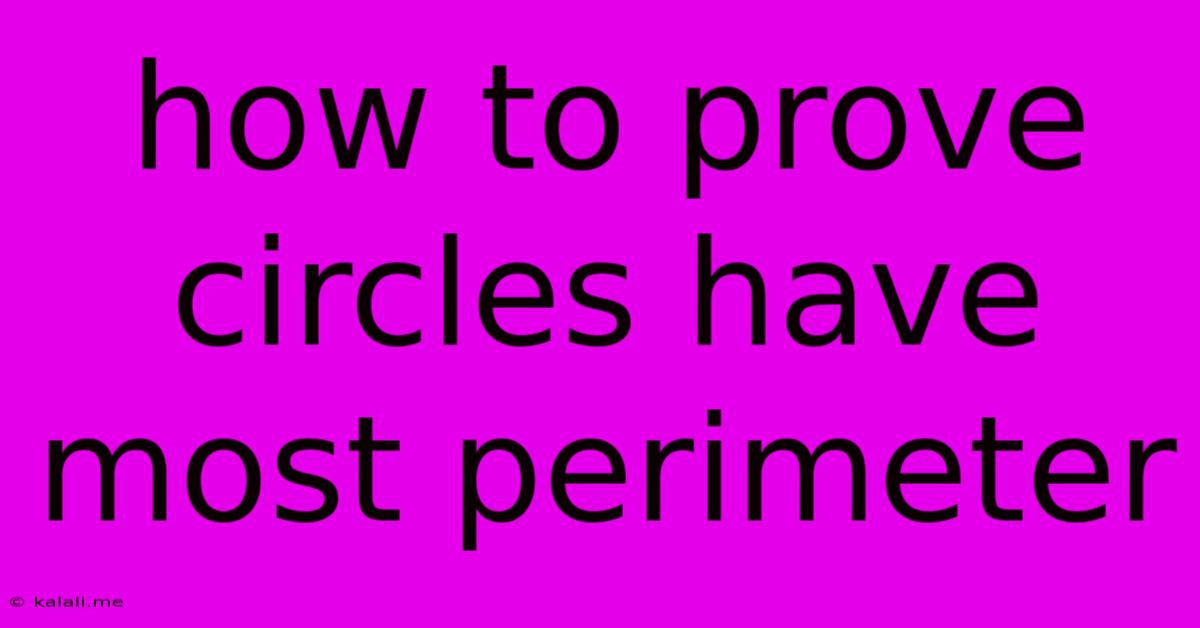How To Prove Circles Have Most Perimeter
Kalali
Jun 06, 2025 · 3 min read

Table of Contents
How to Prove Circles Have the Most Perimeter for a Given Area: A Mathematical Exploration
This article explores the fascinating mathematical proof demonstrating that among all shapes with a given area, the circle possesses the largest perimeter. This is a classic isoperimetric problem with implications in various fields, from nature's optimization strategies to engineering design. We'll break down the proof, making it accessible even without advanced mathematical knowledge. Understanding this concept provides valuable insights into the efficiency of circular forms.
Understanding the Isoperimetric Problem
The isoperimetric problem, at its core, seeks to find the shape that maximizes the enclosed area for a given perimeter or, conversely, minimizes the perimeter for a given area. Intuitively, we might suspect a circle is the answer, but intuition alone isn't enough in mathematics. We need rigorous proof. This problem has applications in various fields, including:
- Nature: Soap bubbles naturally form spheres (in 3D, the equivalent of a circle in 2D) because this minimizes their surface area (perimeter equivalent) for a given volume (area equivalent).
- Engineering: Designing pipes, containers, or other structures often involves optimizing the ratio of perimeter to area for efficiency and material usage.
- Mathematics: It serves as a beautiful example of how optimization problems can be solved using calculus and geometric principles.
The Proof: A Step-by-Step Approach
While a full rigorous proof requires calculus of variations, a simplified approach using geometric arguments and inequalities can provide strong intuition. We'll outline the key steps:
1. Comparing a Circle to Other Shapes:
Consider a shape with a given area, A. Now imagine a circle with the same area, A. Intuitively, we can see that a circle encloses more area for a given perimeter than a square, a triangle, or any other irregular polygon.
2. The Isoperimetric Inequality:
A crucial element in proving the circle's dominance is the isoperimetric inequality. This inequality states:
4πA ≤ P²
where:
- A represents the area of the shape.
- P represents the perimeter of the shape.
This inequality holds true for all shapes. Equality (4πA = P²) only holds for circles.
3. Illustrative Example: Comparing a Square and a Circle
Let's compare a square and a circle with the same area. Suppose the area is 1 square unit.
- Circle: The radius of the circle would be approximately 0.564 units. The circumference (perimeter) will be approximately 3.54 units.
- Square: The side length of the square would be 1 unit. The perimeter would be 4 units.
As you can see, even in this simple example, the circle has a smaller perimeter for the same area.
4. Why Circles Maximize Area for a Given Perimeter (and vice-versa):
The circle's symmetry is key. Every point on the circumference is equidistant from the center. This unique property minimizes the perimeter required to enclose a given area. Any deviation from this perfect symmetry – like creating corners or irregular edges – results in a larger perimeter for the same area.
5. Advanced Mathematical Techniques:
For a fully rigorous proof, one would employ the calculus of variations. This involves analyzing functional derivatives to find the shape that minimizes the functional representing the perimeter while keeping the area constant. This technique proves the circle is the unique solution.
Conclusion:
While a fully rigorous mathematical proof involves advanced calculus, the intuitive understanding demonstrated here, along with the isoperimetric inequality, strongly supports the assertion that among all shapes with a given area, the circle has the largest perimeter. This principle showcases the remarkable efficiency and optimality of circular forms in various aspects of mathematics and the natural world. The circle's symmetrical nature and the isoperimetric inequality are fundamental to this elegant mathematical result.
Latest Posts
Latest Posts
-
How Can I Find Out When A House Was Built
Jun 06, 2025
-
Four Way Stop V Two Way Stop
Jun 06, 2025
-
Sudden Low Water Pressure In House
Jun 06, 2025
-
How To Remove Vinyl Fence Posts
Jun 06, 2025
-
Why No Duty Free Shop At Air Port In Us
Jun 06, 2025
Related Post
Thank you for visiting our website which covers about How To Prove Circles Have Most Perimeter . We hope the information provided has been useful to you. Feel free to contact us if you have any questions or need further assistance. See you next time and don't miss to bookmark.